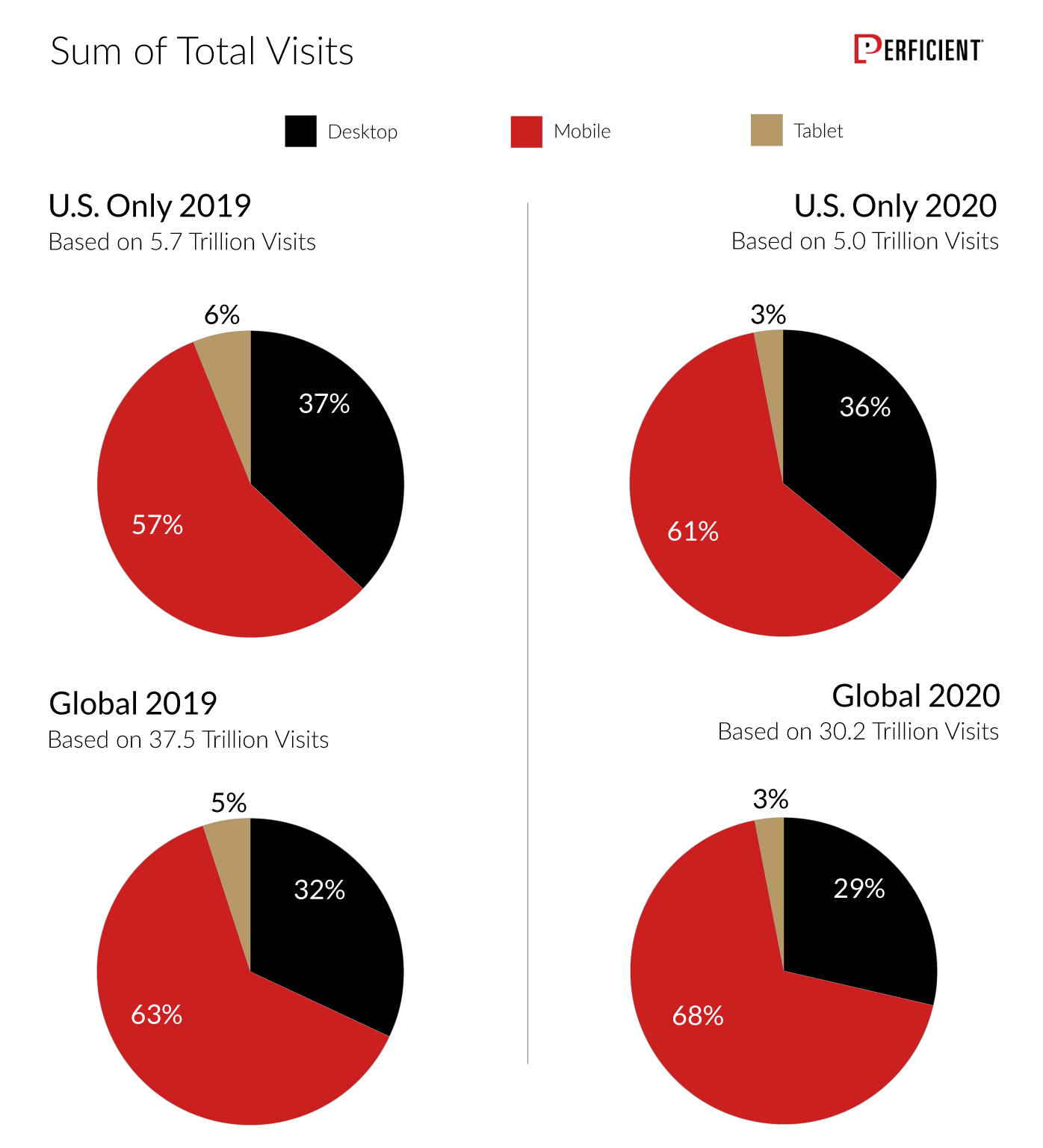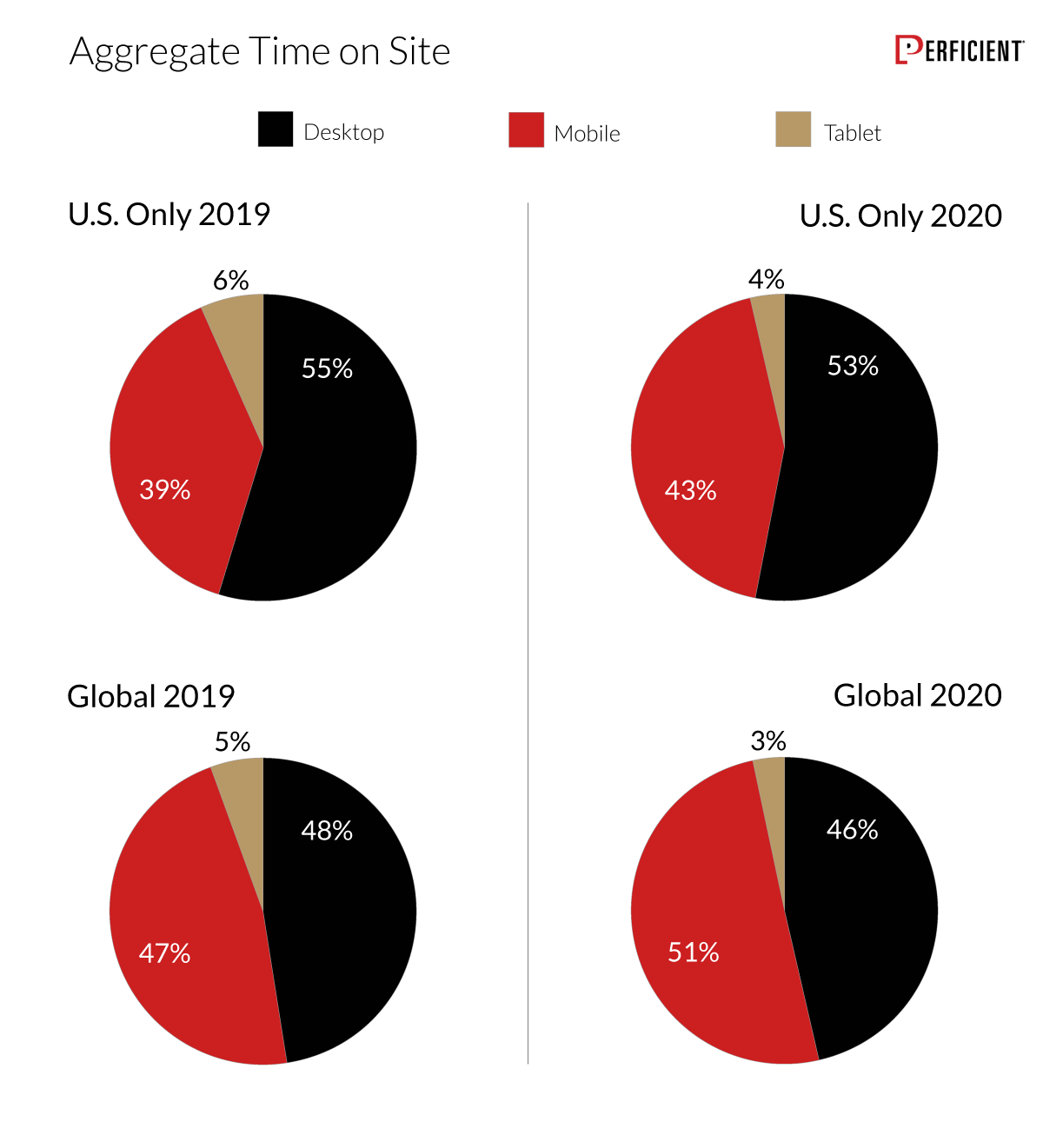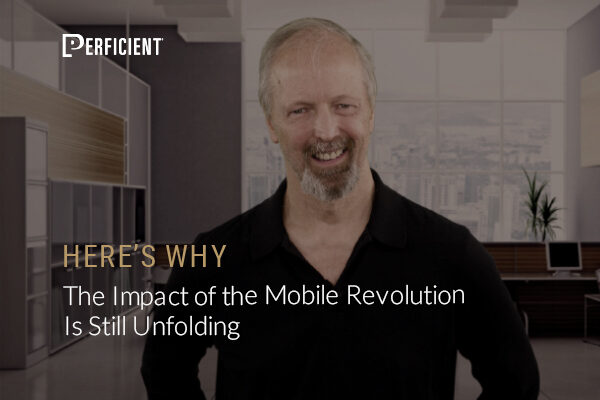We’ve been studying the trend of mobile vs desktop traffic usage since 2016. This year, we looked at mobile vs desktop vs tablet traffic and found that mobile’s dominance continues to grow. With the final adoption of Google’s mobile-first indexing now in effect, it’s never been more important to make sure your site is providing a good mobile experience.
In this episode of the award-winning Here’s Why digital marketing video series, Eric Enge shares results from the study and discusses key areas to focus on to provide the best user experience no matter what device your customers are using.
Don’t miss a single episode of Here’s Why. Click the subscribe button below to be notified via email each time a new video is published.
Resources
- Study: Mobile vs Desktop Usage in 2020
- See all of our Here’s Why Videos | Subscribe to our YouTube Channel
Transcript
Eric: Hey, everybody, Eric Enge here. I’m the Principal for the Digital Marketing Solutions business unit at Perficient. And I’m going to talk to you today about the data from our newest study of mobile versus desktop usage.
We actually first started tracking this in 2016, and the interesting thing is this many years later the growth of mobile’s dominance is just continuing to grow. Particularly interesting to me this year, because in the face of the pandemic, where more people are at home, I had considered the possibility that maybe people would be spending more time with their desktop devices, if they have them, of course, just because they were at home anyway, and they weren’t out and about. But what we, in fact, saw was continued growth. But I’ll get into that in a moment.
First of all, I just want to let you know, this year, we used the Google Benchmarking tool for our analysis. It allowed us to get some really good detailed and comprehensive numbers. But let’s actually take a look.
First of all, as I’m showing you now, in 2020, and in the U.S., 61% of visits to websites came from mobile devices. This is up from 57% in 2019.

And globally, 2020 saw 68% of visits started from mobile devices with 2019 coming in at 63%. So, as has been the case since the beginning of the study, the volume or the percentage of mobile outside the U.S. is greater than it is inside the U.S. just because there are countries where mobile devices are the primary, or even the only way, people access the web.
But, it’s interesting if you look at those levels of growth, 57 to 61 and 63 to 68. That’s still a pretty strong trajectory upwards. And that was a bit of a surprise to me given the past year. But nonetheless, desktop still leads in total aggregate time spent on site by users.
And the reason for this is the desktop sessions tend to be a bit longer. So, in the U.S., for example, 53% of all time on site was on desktop devices versus 43% for mobile, with the balance going to tablet devices.

As you might expect, therefore, mobile also lags by having the highest bounce rate and the lowest page views per visitor. And that’s not a big surprise. And these numbers fit our, really, our intuitive expectations for behavior because, mobile devices, smaller keyboard, smaller screen. So, if I really have some more in-depth stuff I want to do, then I’m more likely to use a larger screen and keyboard if I have it.
But it’s also fair to say, thinking about all this, the industry is still maturing with respect to its skill and things like mobile design and mobile user experience and mobile customer experience. And to that end, I want to talk a little bit about what this all means.
So, Google is now very close to the final adoption of mobile-first indexing. Most sites are already there, but whoever isn’t there by end of March 2021, Google’s flipping the switch. And then in May, we have the upcoming Core Web Vitals algorithm release. And as I think about what this means is, to me, what it means is that various aspects of consumer experience or customer experience and user experience and design are becoming increasingly critical to your overall digital marketing program and investments.
Some of this influences SEO directly, some influences SEO indirectly, and they all impact conversion rate. And because of that, all these things influence your ROI on your SEO investments, or for that matter, any of your digital marketing investments where sending people to the website is a primary target.
And I still see too many companies that begin their web design projects with a desktop-first mentality. Users and Google both have left that far behind, so it’s essential that you do the same. And that means there are several areas that you need to think about from the point of view of what you’re doing with your mobile experience.
Obviously, ease of navigation, the power and accuracy of your site search, and the comprehensiveness of your content. And it’s interesting. So, when you think about comprehensive content, what I want to get you to think about here is you need to have all the same content that you envision having on your desktop site. And that I see more complicated to put into a mobile design format, but it just means you need to invest the energy to make sure that your navigation and your overall design still gives you that clean, simple feel and look where people feel comfortable, and they can find what they want quickly, but they can still get to comprehensive levels of content. So, there’s a lot for us to learn there as an industry, I think, still.
Site speed is huge too. I can’t tell you, every prospect site that I look at working here at Perficient, it’s like a given, I’m going to go check their site speed, and it’s going to be kind of abysmal. It’s so common. And obviously, I see exceptions, but it’s an area that’s so underinvested in, partly because it’s hard to do and people don’t fully understand how to attack it.
And the other thing that you need to think about is just avoiding things that block users from getting what they want. Interstitial is just an example of that. But ultimately, it’s a new day, right? I mean, this has been coming for a long time. And some people were very aggressive and got out in front of it and they’re reaping the rewards of that. But if you haven’t, it really needs you to bring forth a new focus and realize that it does create new opportunities to get in front of those who are still lagging behind and being slow to react. Take advantage of this opportunity while you still can.
So, I hope you enjoyed today’s episode of “Here’s Why.” And if you did, please click on the Subscribe button below so you won’t miss any future episodes.
Don’t miss a single episode of Here’s Why. Click the subscribe button below to be notified via email each time a new video is published.
See all of our Here’s Why Videos | Subscribe to our YouTube Channel
